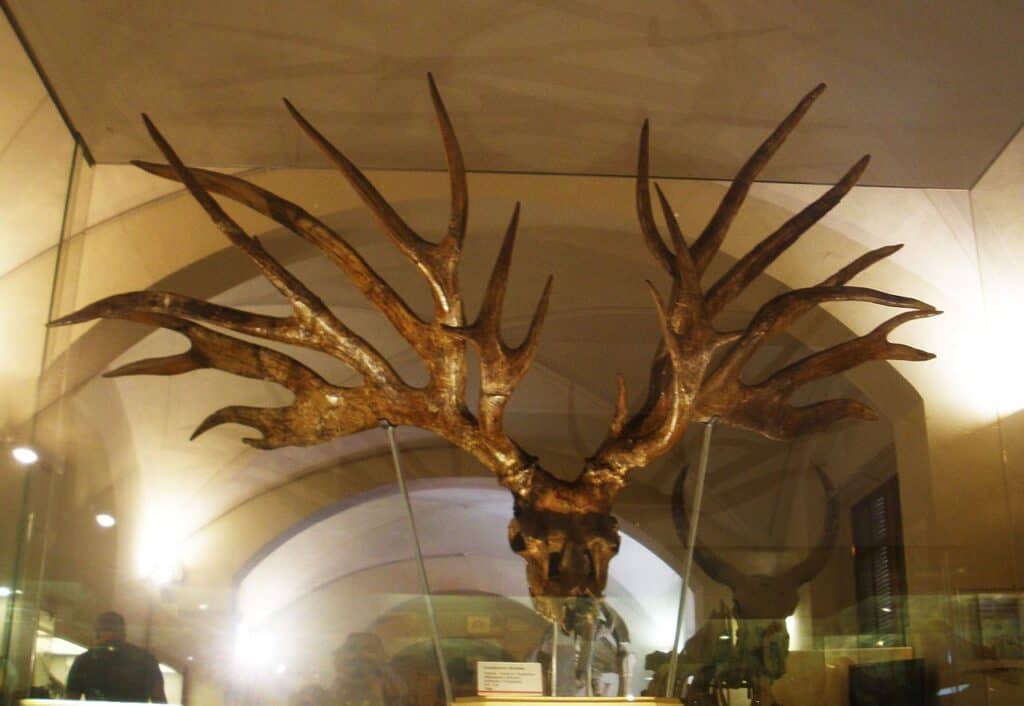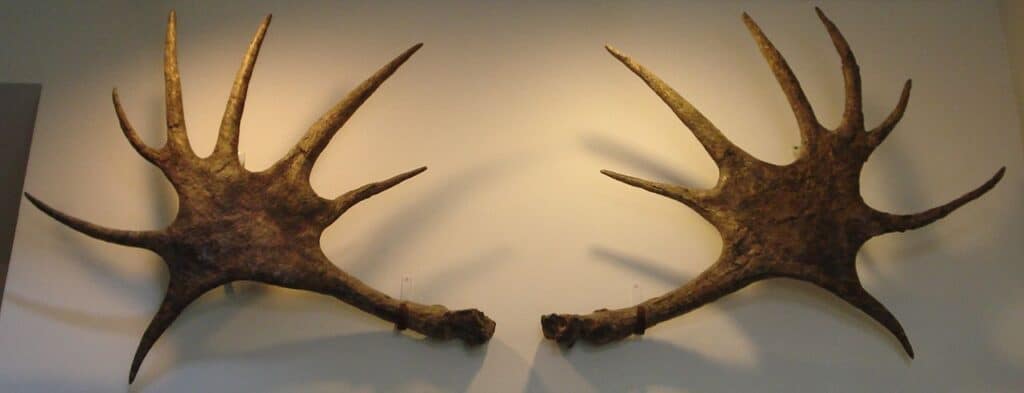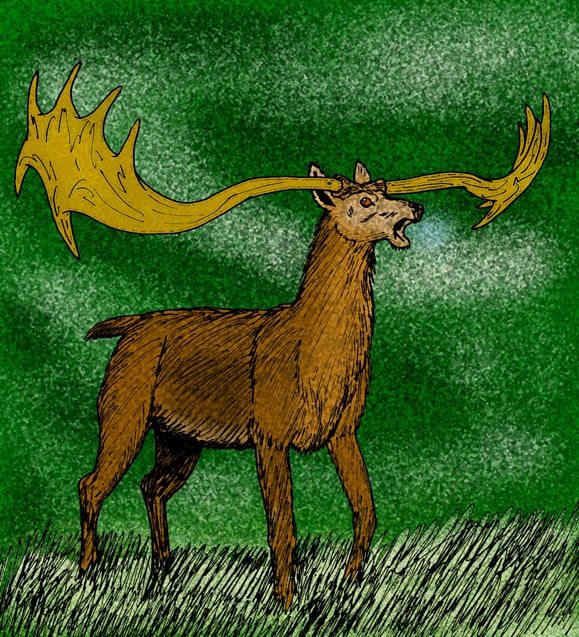Extinct giant moose and other massive prehistoric deer were truly a force of nature. From enormous Irish elk to the heavyweight broad-antlered deer, these prehistoric Cervidae roamed the planet for millions of years before eventual extinction in the last Ice Age.
Let’s find out a bit more about these impressive herbivores whose size was off the charts, but before we jump in – what exactly is a deer?
A deer is a member of the scientific family Cervidae. They are herbivores with hooves, and the males have antlers. There are many species of deer but antelope species, such as the springbok, are not deer.
Instead, they are part of the Bovidae family alongside sheep, goats, and cattle. The main difference is that deer have branching antlers that shed and regrow, whereas antelope have permanent single horns.
Now that’s cleared up, let’s look at extinct giant moose and other massive prehistoric deer!
Stag Moose (Cervalces scotti)

The
extinct
stag moose was enormous, and it stood 12 feet tall and weighed 1,500 pounds.
©Staka / CC BY-SA 4.0 – License
Also called an elk-moose, this massive prehistoric deer lived in the late Pleistocene era and was resident in modern-day North America. It weighed around 1,500 pounds and stood 12 feet tall.
Its body was similar to a modern-day elk with long skinny legs, but its head was more like a deer with palmate branching antlers.
Stag-moose were adapted to ice age snow. They had warm fur and sharp hooves to break through ice or dig beneath the snow for greenery. They probably lived in marshes, swamps, and open woodland as modern moose do today.
Paleontologists have found 20 stag moose remains in Iowa and Wisconsin, and the oldest fossilized specimen was discovered in 1805 at Big Bone Lick, Kentucky.
We’re lucky that so many fossils have been found so we can find out about this giant extinct deer.
Irish Ek (Megaloceros giganteus)

The Irish elk had massive antlers that were 12 feet in width
©Daniel Eskridge/Shutterstock.com
Irish elk were huge prehistoric deer with a massive antler span. Despite their name, they weren’t elk but a member of the Cervidae family of deer with hooves and antlers. Irish elk got that name from the number of preserved bodies found in Irish peat bogs.
An Irish elk weighed 990-1,520 pounds and stood as tall as an Alaskan moose at 6 feet 11 inches, but their antlers were so staggering.
This prehistoric deer’s antlers measured a massive 12 feet wide. That’s six feet on either side and roughly the same length as two refrigerators.
From cave art, we know that an Irish elk had pale fur with a dark stripe on its shoulders and back. It also had a dark collar and a hump between its shoulders. This specific description is taken from the Lascaux cave art in southwestern France, painted 17,000 years ago by prehistoric humans.
Along with other megafauna species, including woolly mammoths and giant sloths, Irish elk became extinct at the end of the last ice age, around 10,000- 8,000 years ago.
Bush-Antlered Deer (Eucladoceros dicaranios)

Fossilized remains of the bush-antlered deer indicate they died out at the same time as other ice age megafauna around 10,000 years ago.
©Ghedoghedo / CC BY-SA 3.0 – License
Bush-antlered deer stood shorter than others on this list at 5 feet 9 inches, but it had amazing antlers hence its name ‘bush-antlered deer.’
Their incredible antlers were five feet six inches wide with complex, comb-like shapes. They had 12 tines per pedicle! It’s thought Eucladoceros was the first deer genus to have highly evolved antlers.
This genus of prehistoric deer is found across Asia and Europe. Fossilized remains indicate they died out at the same time as other ice age megafauna around 10,000 years ago. Massive carnivores of the time, including the terrifying dire wolf, preyed on bush-antlered deer.
Their antlers were so intricate that this inspiring deer was added to the Zoo Tycoon 2 game in the extinct species pack.
Broad-Fronted Moose (Cervalces latifrons)

Experts think broad-fronted moose were solitary creatures that grazed grasslands and ate herbs from swamp and marsh edges.
©Ghedoghedo / CC BY-SA 3.0 – License
Broad-fronted moose is probably the heaviest deer ever to exist. It was huge, standing 6 feet 11 inches at the shoulder, and weighed 2,200 pounds.
Like most prehistoric deer, it had large antlers, but theirs were palmate with up to ten points.
Experts think broad-fronted moose were solitary creatures that grazed grasslands and ate herbs from swamp and marsh edges. It lived in Asia and Europe and most likely became extinct 100,000 years ago, a long time before Irish elk, and other massive prehistoric deer died out 10,000 years ago.
Some scientists think the broad-fronted moose evolved into the stag moose or the modern moose, but there isn’t enough evidence to be certain. It could be that broad-fronted moose became extinct.
Even though this was the largest and heaviest deer to exist, it was prey to the massive carnivorous steppe brown bear and short-faced bear, which may have weighed up to 2,200 pounds as well but on their back legs were over nine feet tall.
Broad-Antlered Deer (Libracles)

Despite having 6 feet-wide antlers, the broad-antlered deer wasn’t very large.
©Stanton F. Fink / CC BY-SA 2.5 – License
Some paleontologists think the broad-antlered deer was the forefather of the Irish elk due to its massive antler width, but others consider it an ancestor of moose. We can’t tell for sure.
This prehistoric deer lived in the Pliocene epoch 5,333 million to 2,58 million years ago. That makes it the oldest deer on this list, and as a result, we know very little about it.
Despite having 6 feet-wide antlers, the broad-antlered deer wasn’t very large and was probably the size of a modern-day deer. Fossilized remains found in France and a few other not-so-complete remains across Europe and Asia doesn’t give scientists much to go on.
When And Why Did Giant Deer Go Extinct?

Deer with smaller antlers may have survived the last Ice Age because they needed less food to sustain antler growth.
©Sourabh Bharti/Shutterstock.com
We don’t know why the oldest prehistoric deer on this list became extinct. The broad-antlered deer and the broad-fronted moose may have evolved into later species of deer, but for massive deer alive in the Pleistocene period, their extinction corresponded with two events.
The first was climate change. At the end of the ice age, the climate was unstable. It was extremely cold and then warmed as the ice sheet melted. This would have put pressure on giant deer food sources. Giant moose and other massive prehistoric deer needed lots of vegetation to sustain their antler growth. This could be why the big ones became extinct, but smaller species of deer survived.
The second reason is that their extinction coincidences with prehistoric human activity. It’s thought humans hunted giant deer, along with cave lions, dire wolves, and massive bears. On a population already under pressure to find enough food to keep up their huge antler development, it could have tipped them over into extinction. This article from the journal Evolutionary Ecology Research talks about the impact of huge antlers and climate change on prehistoric deer.
That concludes our list of extinct giant moose and other massive prehistoric deer. Not only were they enormous, but they also had huge impressive antlers we don’t see today.
It’s a shame we won’t get to see these magnificent deer in person, but perhaps their extinction serves as a warning about what can happen when climate change takes hold.
The photo featured at the top of this post is © Daniel Eskridge/Shutterstock.com
Thank you for reading! Have some feedback for us? Contact the AZ Animals editorial team.






